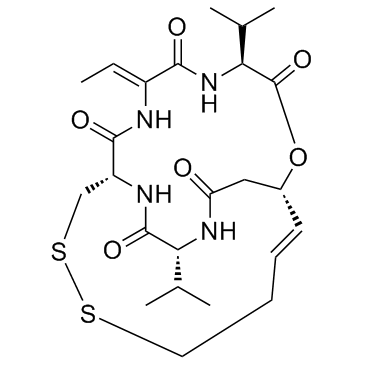| DC73305 |
TYA-018
|
TYA-018 (TYA018) is a potent, isoform-selective inhibitor of HDAC6 with IC50 of 10 nM, inhibits tubulin acetylation (Ac-Tubulin) with EC50 of 120 nM in cell-based assay in induced pluripotent stem cell-derived cardiomyocytes (iPSC-CMs). |
| DC70854 |
Tucidinostat
|
Tucidinostat (Chidamide, HBI-8000, CS055) is a novel histone deacetylase (HDAC) inhibitor with IC50 of 95/160/67/733/78/432 nM for HDAC1/2/3/8/10/11, respectively; shows no activity against Class IIa HDAC4/4/7/9 and HDAC6; demonstrates significant and broad spectrum in vitro and in vivo antitumor activity, induces G1 arrest, ROS-dependent apoptosis and differentiation in human leukaemia cells. |
| DC70821 |
T-518
|
T-518 (T518) is a potent, highly selective, brain penetrant, oral HDAC6 inhibitor with IC50 of 36 nM.T-518 did not obviously inhibit human HDAC1, 4, or 7 at 10 uM, which belongs to Class I or Class IIa HDAC.T-518 showed brain penetration in an oral dose and blocked HDAC6-dependent tubulin deacetylation at Lys40 in mouse hippocampus.T-518 decreased RIPA-insoluble tau accumulation (3-month treatment, 1 and 3 mg/kg), restored impaired axonal transport and novel object recognition in the P301S tau Tg mouse (tauopathy model) by 2-week treatment with dose 1 and 3 mg/kg. |
| DC70534 |
KA2507
|
KA2507 (KA-2507, KA 2507) is a potent and selective inhibitor of HDAC6 with IC50 of 2.5 nM, >300-fold selectivity over other HDACs.KA2507 demonstrated cellular potency (IC50=150 nM) in a cellular assay measuring induction of acetylated α-tubulin, a marker of HDAC6 inhibition.KA2507 displays antiproliferative effects against a set of 93 human cancer cells with IC50 of 2-30 uM.KA2507 inhibits tumor growth in the syngeneic B16-F10 mouse melanoma model. |
| DC70478 |
HDAC3 inhibitor PT3
|
HDAC3 inhibitor PT3 is a novel potent, selective, BBB-permeable HDAC3 inhibitor.PT3 exhibited higher selectivity for HDAC3 over HDAC1, HDAC6, and HDAC8 compared to the reference compound CI994.PT3 upregulated H3K9 acetylation, CREB 1, BDNF, TRKB, Nr4a2, c-fos, PKA, GAP 43 and MMP9 expression in mouse neuronal (N2A) cells.PT3 significantly improved the discrimination index in C57/BL6 mice in the novel object recognition (NOR) model, significant increased in H3K9 acetylation in hippocampus.PT3 upregulated CREB 1, BDNF, TRKB, Nr4a2, c-fos, PKA, GAP 43, PSD 95 and MMP9 expression in mice treated with PT3. |
| DC70420 |
FT234
|
FT234 (FT-234) is a selective HDAC11 inhibitor.FT234 demonstrated significant reduction in self-renewal stem-like SP cells with 2 uM FT234 or FT895, as well as the formation of vascular networks by SP cells at 5 uM compound treatment.FT234 significantly decreased the mRNA of Sox2 as well as its target genes like HK2 and PDK2 in SPAdh cells.FT234 compound inhibited the growth and viability by 60–80% in both A549 and H1650 cells at 5-10 uM, inhibited the viability of cancer cell lines A549 and H1650 ranged from 4.663–6.594 uM, reduced the viability of chemo-resistant cancer cells as well as chemo-insensitive CSCs.FT234 selectively prevent growth of cancer cells in presence of cancer associated fibroblasts (CAFs). |
| DC70098 |
KT-531
|
KT-531 (KT531) is a potent, selective HDAC6 inhibitor with IC50 of 8.5 nM, displays 39-fold selectivity. |
| DC49587 |
CYD19
|
Snail/HDAC-IN-1 is a potent Snail/HDAC dual target inhibitor. Snail/HDAC-IN-1 displays potent inhibitory activity against HDAC1 with an IC50 of 0.405 μM and potent inhibition against Snail with a Kd of 0.18 μM. Snail/HDAC-IN-1 increases histone H4 acetylation in HCT-116 cells and decreases the expression of Snail protein to induce cell apoptosis. |
| DC49583 |
Elevenostat
|
Elevenostat (JB3-22) is a selective HDAC11 inhibitor (IC50=0.235 µM). Anti-multiple myeloma (MM) activity. |
| DC7673 |
Splitomicin
|
Splitomicin is a derivative of β-naphthol is an inhibitor of Silent Information Regulator 2 (SIR2). |






















